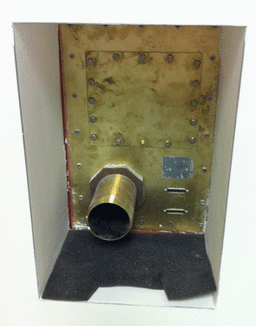It is true that the MR scanner room is well-shielded against radiofrequencies going in or out by virtue of its magnetic cage construction. Any structure (e.g., wire, pipe, or duct) traversing the wall must pass through a penetration panel that contains RF-filters and waveguides.
|
An RF-bandstop filter is a passive electronic element consisting of inductive and capacitive components placed in series with the electrical line that penetrates the enclosure. This filter allows passage of all frequencies except those in a narrow range surrounding the Larmor frequency.
For pipes, ducts, fiber optic cables, and tubing a different type of filter is needed, called a waveguide. The type of waveguide used in MR facilities is usually a circular (cylindrical) type with a cutoff well above the Larmor frequency. In the range of frequencies used in MRI (10-300 MHz) a cylinder with a length:width ratio of 4:1 or greater will be effective at blocking radiofrequencies in the desired range. For those interested in the underlying theory for how this works, an advanced reference is provided. |
Advanced Discussion (show/hide)»
No supplementary material yet. Check back soon!
References
ETS-Lindgren. MRI shielding architectural site planning guide. September, 2009:1-34.
Poole I. Waveguide cutoff frequency. Radio-electronics.com. (A brief explanation of how waveguides work).
ETS-Lindgren. MRI shielding architectural site planning guide. September, 2009:1-34.
Poole I. Waveguide cutoff frequency. Radio-electronics.com. (A brief explanation of how waveguides work).
Related Questions
What is the purpose of RF-shielding?
What is the purpose of RF-shielding?

